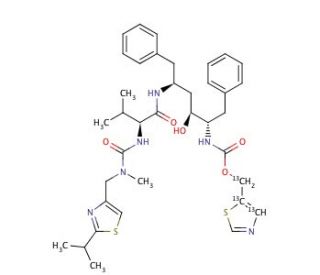

Ritonavir-13C3 (CAS 1217673-23-8)
See product citations (1)
QUICK LINKS
The core mechanism of action of ritonavir involves the inhibition of HIV-1 protease, an enzyme crucial for the proteolytic cleavage of the viral polyprotein precursors into individual functional proteins. This inhibition prevents the maturation of the virus, effectively halting its replication cycle. Ritonavir-13C3, by retaining the structure of the parent compound, exhibits this same mechanism of inhibition. In research settings, ritonavir-13C3 is particularly useful for tracing and understanding the absorption, distribution, metabolism, and excretion (ADME) of the parent molecule. Scientists use this isotopically labeled compound in mass spectrometry to achieve more precise measurements, as the distinct mass of carbon-13 allows for clear differentiation from endogenous substances. Additionally, studies involving ritonavir-13C3 have contributed to the development of analytical methods for detecting the substance in biological samples. Researchers have also used this compound to investigate the interaction of the parent molecule with various proteins in the body, including its well-known effect on cytochrome P450 enzymes, which are involved in the metabolism of many substances. Through the use of ritonavir-13C3, researchers can generate detailed metabolic profiles that help in understanding how the parent molecule behaves in different biological systems, aiding in the design of studies related to interactions and the optimization of dosing strategies.
Ordering Information
| Product Name | Catalog # | UNIT | Price | Qty | FAVORITES | |
Ritonavir-13C3, 500 µg | sc-219980 | 500 µg | $460.00 |
